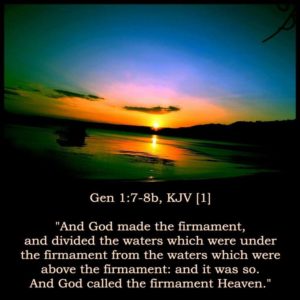Feb
20
Does the Old Testament Teach a Three-Tiered Cosmology?
“Job 37:18, which describes skies without rain as a ‘bronze’ expanse (cf. Deut 28:23), is figurative and does not support the common contention that the ‘expanse’ was considered a bronze dome by the Hebrews.” — Kenneth Mathews, Genesis 1–11:26 (New American Commentary, vol. 1a)

For roughly the past couple hundred years, certain scholars (mostly higher critics and skeptics) have popularized the idea that the ancient Hebrews believed that the Earth was flat and a hard(?) dome or vaulted sky rested upon it. This is purported to have been taught in Jewish scripture. The claim is made with such authority that some Christians have come to believe it, as well, and the idea (along with graphics like the one here) appear in some Bible dictionaries and commentaries. But, is it necessarily true?
To the contrary, I believe that a compelling case — at least as strong, maybe stronger — can be made textually and linguistically that the ancient Hebrews did not hold this view, nor does the Bible teach it. Once again, I turn to Dr. Walter Kaiser to explain…
— — —
“Few results of scholarly thinking have found more unanimity than on the point of linking the Bible’s view of the world with ancient cosmology. Usually the point is made using elaborate diagrams that the Hebrews shared a very primitive view of cosmology. They talked, it is claimed, about a flat earth (Is 11:12; Rev 20:8), capped allegedly with a solid firmament (Gen 1:7-8, and elsewhere), which roof was appropriately outfitted with windows in the solid sphere over the top of the earth (Gen 7:11; 8:2; 2 Kings 7:2; Is 24:18, and elsewhere). The whole flat earth and solid firmament were supported by pillars (e.g., 1 Sam 2:8; Job 9:6), which stretched up past the underworld of sheol and the “deep.”
R. Laird Harris has shown that each step in this allegedly biblical diagram depends more on the ingenuity of the modern scholars than it does on the assertions of the original writers of Scripture. To begin with, nowhere does the Hebrew text state or imply that the raqia’ (often translated “firmament,” but better translated as “expanse”) is solid or firm. It is simply an “extended surface” or an “expanse.” The idea of “firmness” or “solidity” came more from the Latin Vulgate translation of “firmamentum” and the Greek Septuagint translation of steroma than it did from any Hebrew conceptualization.

The “expanse” of the heavens did not imply or call for a sort of astrodomelike structure. Raqia’ is used both in Genesis 1 and in Ezekiel 1 and 10. Certainly in Ezekiel it also means an extended platform, or an expanse on which the throne of God is situated. Attempts to translate the Hebrew term as a “strip of metal” are as fruitless as those that have attempted to link some sort of hardness with raqia’ in order to match this Hebrew concept with the upper half of Tiamat’s body that became the sky in Babylonian mythology. On the contrary, if one needs a concrete picture of the heavens, what about the poetic reference to the heavens being rolled up like a scroll (Is 34:4; 40:22)?
As for the windows in heaven, presumably to let in starlight and rain, the creation story never mentions such. The first place where the concept of “windows” appeared is in the flood story. Thereafter, other things come through those “windows,” including “barley” (2 Kings 7:1-2), “trouble” and “anguish” (Is 24:18), and “blessing” (Mal 3:10).
Neither is the case for a flat earth all that convincing — at least no more convincing than when modern newscasters claim that their news bureau has gone to the “four corners of the earth” to gather their news. Rarely do moderns shout at their TV sets, “Copernicus!” These are legitimate literary conventions to designate in most cases the four points of the compass. Other passages speak just as openly of the “circle of the earth” (e.g., Is 40:22).
The subterranean features, including the pillars that allegedly support the earth, sheol and the “waters under the earth,” on close examination also fail to uphold the “triple-decked” or “three-storied” concept of the universe. The “waters under the earth” easily qualify as the waters below the shoreline where the fish dwell, for no sinkers exist to send fishing lines down to hell (Deut 4:18). “Sheol” is merely the poetic word for the “grave” in all sixty-five of its appearances. Some passages, it is true, do refer to the “foundations” of the earth as resting on “pillars,” but both terms are used metaphorically as we continue to do to this day. And what shall we say about Job 26:7 that has the earth resting on nothing?

The so-called primitive view of cosmology in the Bible turns out to be a contrived view that cannot bear up under examination. Nor is the case strengthened by appealing to the alleged wet cosmology of Genesis 1 vis-a-vis the alleged dry cosmology of Genesis 2:4-14. The second chapter of Genesis concentrates on the garden where the first human couple were placed and not on a world cosmology such as Genesis 1 does. This is a typical literary convention of the writer of Genesis. First, the writer will trace matters broadly, then turn to the more detailed and specific matter that he is wishing to address.
Perhaps a modern analogy might help. J. Stafford Wright has drawn our attention to the metaphorical use of words in such scientific terminology as is used in psychoanalysis and analytical philosophy. In these disciplines it is most common to speak of the threshold of consciousness, the subconscious, the super-ego, and the depths of the psyche. A critical reader a thousand years hence might think that these modern scholars held to a “three-storied” concept of a solid mind that had doors, depths and gates. We know how wrong they would be, but yet we insist on maintaining that similar phrases and clauses in the biblical record do indeed betray a primitive mind-set and a primeval cosmology. How can one break that modern insistence to believe what one wishes to believe or to disbelieve it since it came earlier and therefore must be more simple and primitive? It is a hermeneutical spiral or circle that is difficult for Western minds to break.”
— — —
Several issues around this topic could be resolved by recognizing the Bible’s (thus, God’s) use of similes, metaphors, and other phenomenological language. Yet, those who push the “three-tiered Hebrew cosmology” view often are the same ones who say that those who don’t accept it are being, among other things, too literalist. As Randall W. Younker and Richard M. Davidson (see link below) observed:
“One of the great ironies in recreating a Hebrew cosmology is that scholars have tended to treat figurative usages as literal (e.g., Psalms and Job), while treating literal passages such as in Genesis as figurative.”
Why is that?
Proponents are typically committed to an accommodationist approach to Scripture and the idea that the Hebrews concocted their cosmological (and perhaps other) views by borrowing and adapting those of neighboring cultures (e.g., Babylonian, Sumerian, Akkadian). Sadly, this position is often accompanied by a generally condescending attitude that belittles the ancient, pre-scientific Hebrews as well as any modern Christian creationists of a literalist and/or concordist persuasion (i.e., what they often disparagingly term “fundamentalists” or “fundies”).
Nevertheless, it is a fascinating topic that I wish I had more time to delve into.
P.S. For more info, check out the good (but not without its problems) article “The Myth of the Solid Metal Dome” by Younker and Davidson.
P.P.S. For a response to Younker and Davidson from the 3-tier camp, see this video here.















